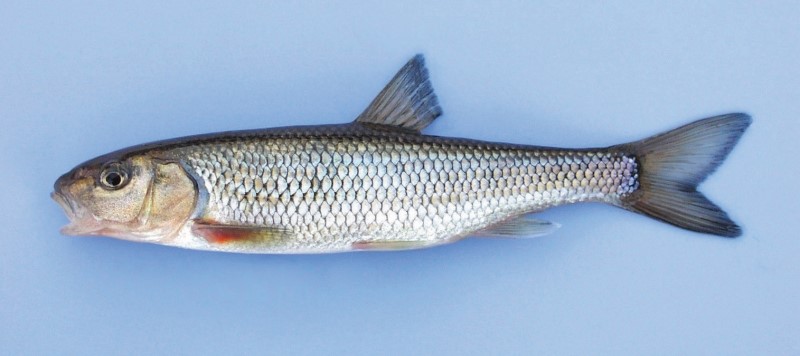Fallfish (Semotilus corporalis) - Native


A husky 12-inch adult fallfish (top). Male fallfish can get very dark during the spawning season (bottom).
Identification. Similar to the creek chub, but with larger scales (fewer than 50 lateral line scales) and no black spot on dorsal fin. Streamlined shaped. No distinctive blotches or markings. Forked tail. A small barbel in the groove over and a little in front of the end of the jaw. Base of first ray of dorsal fin directly over pelvic fin base. Scales along side in front of the dorsal fin and above lateral line are similar in size to those behind the dorsal fin. Mouth large, end of jaw reaching at least to front edge of eye. Adults often have distinctive dark pigment along the forward edge of many scales. Generally dark gray on back fading to silver on sides and white on belly. Pectoral, pelvic and anal fins often reddish in adults. Spawning males can get very dark, with their heads developing a brownish to reddish hue and becoming covered with small, horny bumps (nuptial tubercles). Juveniles are silvery and typically have a dusky lateral band.
Size. Commonly 4 to 9 inches. State survey max. size 16.5 inches. Max. reported size 20 inches.
Distribution. Northeastern United States and neighboring parts of Canada. Found in most Connecticut streams, where they can be common to abundant.

Habits. Prefer small to medium-size streams with gravel or cobble bottoms. Sometimes occur at low abundance in lakes with significant tributary streams. Very easy to catch on bait (worms work well) or small lures and flies.
Comments. This is our largest native minnow species. Fallfish build large, distinctive nests in streams for the incubation of their eggs. The nests are pyramid-shaped piles of small rocks that vary in height from 4 to 18 inches. Although fallfish are commonly caught by Connecticut anglers fishing for trout in streams, few people correctly identify them, often simply referring to them as “dace” or occasionally thinking they’re some kind of trout.

A typical 6-inch fallfish. Note large scales, many with dark pigment along their forward edges.
Text and images adapted from Jacobs, R. P., O'Donnell, E. B., and Connecticut DEEP. (2009). A Pictorial Guide to Freshwater Fishes of Connecticut. Hartford, CT. Available for purchase at the DEEP Store. The fish distribution maps were created in 2009. For updated fish distributions please use the CT DEEP Fish Community Data Interactive Map.

